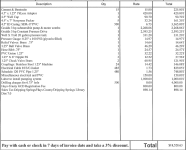My client base was about 70 and all had pumps, with 1/2 drawing from lake and rest from wells.
Only one client needed to replace a pump and that was because his well went dry.
I would guess 90% of the pumps were between 20 and 35 years old.
The control boxes and pressure switches were the most common faults. Newer controls use solid state relays which are far superior to the old style.
More common problem was the pressure tanks, with bladder type often failing at 12 years or so. (guess that bladder can only take so much flexing)
Next often problem was simple crap plugging the small line at the pressure control switch, but that is a cheap easy fix. (like $25,00 part)
All that to say that pumps are very well engineered products that rarely fail.
OK, some will fail due to sand injection (worn vanes) but all in all they are very well constructed and have an exceptional life.
(Of interest just about every pump used the same Franklin power head )
PS
You know if a bladder tank or pressure switch has gone faulty if the pump surges on/off whenever you open a facet or flush a toilet.
A typical setting is for the cut in to be 3-4 PSI below the tank or bladder air pressure.
